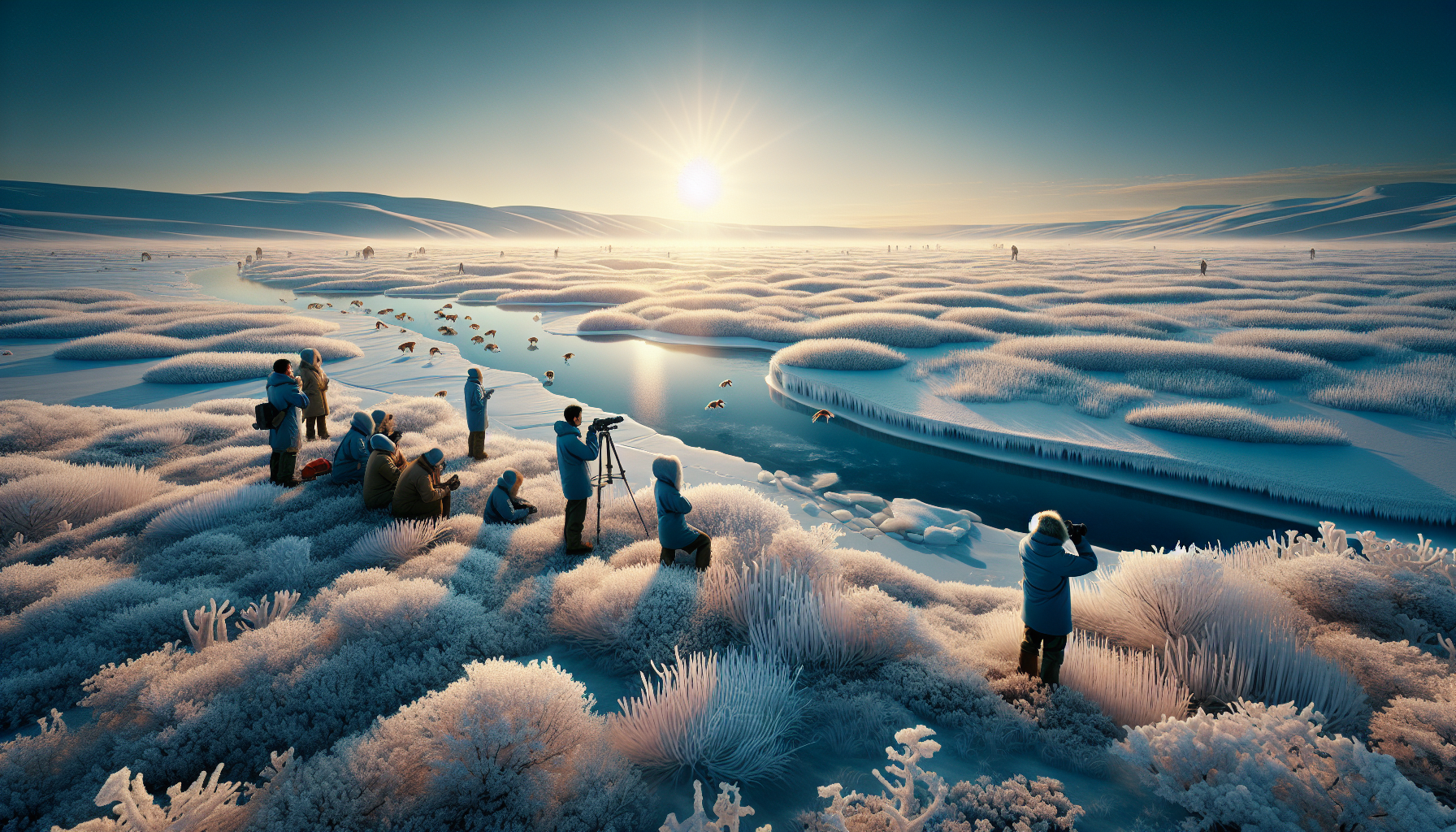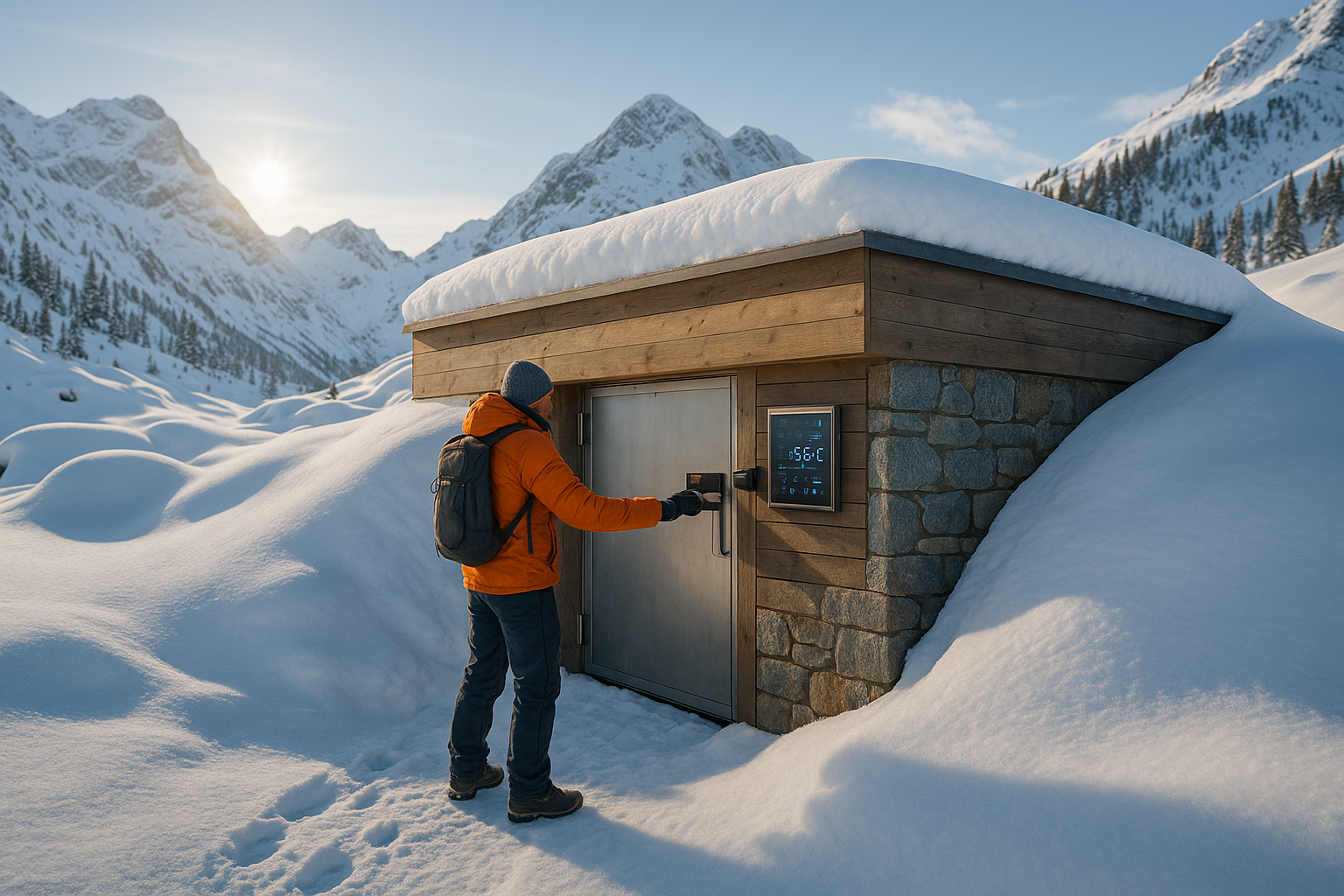In the vast, unyielding expanses of our planet’s polar regions lies a silent yet crucial guardian of Earth’s climate stability: permafrost. This frozen layer of soil, sediment, and rock, spanning millions of square kilometers, acts as a time capsule, preserving within it ancient organic materials and gases. Yet, beyond its scientific intrigue, permafrost plays a pivotal role in regulating our planet’s temperature. As we stand on the precipice of unprecedented climate change, the preservation of permafrost emerges not merely as an environmental concern but as a testament to our commitment to future generations. The “frozen frontier” is more than just an icy expanse; it is a crucial battleground in the fight against global warming, holding within it both the secrets of the past and the keys to a sustainable future.
Imagine a world where this natural freezer begins to thaw at an alarming rate. The consequences extend far beyond the immediate landscapes of tundra and boreal forests. Melting permafrost has the potential to release vast amounts of carbon dioxide and methane—potent greenhouse gases—into the atmosphere, amplifying the effects of climate change and setting off a cascade of environmental challenges. This process, known as the permafrost carbon feedback, is one of the most pressing yet underappreciated components of the global climate system. The urgency to address this issue is clear: if we fail to act, the ramifications could be felt worldwide, affecting everything from global weather patterns to the livelihoods of indigenous communities who call these icy realms home. In this article, we’ll explore the science behind permafrost, the dangers of its degradation, and the innovative strategies being developed to preserve it for future generations.
As we journey through this discussion, we will delve into the intricate dynamics of permafrost ecosystems, examining the delicate balance they maintain and the catastrophic potential of their disruption. We’ll shed light on cutting-edge research and technological advancements aimed at monitoring and mitigating permafrost thaw, from satellite surveillance to ground-based innovations. Moreover, we’ll highlight the voices of indigenous communities, whose traditional knowledge and stewardship offer invaluable insights into sustainable practices. Together, these perspectives form a holistic approach to permafrost preservation, emphasizing the importance of global cooperation and proactive policy-making. Join us as we uncover the mysteries and challenges of the frozen frontier, understanding that the actions we take today will resonate far beyond our lifetimes, shaping the legacy we leave for those who come after us. 🌍❄️
Understanding Permafrost: Nature’s Icebox
Permafrost, a term derived from “permanent frost,” refers to a thick subsurface layer of soil that remains below freezing point throughout the year. This naturally occurring phenomenon is crucial for various ecosystems, playing a vital role in the global climate system. It can be found extensively in polar regions and certain alpine areas, covering nearly 24% of the land in the Northern Hemisphere. Understanding the composition and significance of permafrost is essential for recognizing its impact on both local and global scales.
The frozen layers of permafrost are composed primarily of soil, rock, and organic matter that have been trapped in a frozen state for thousands of years. The thickness of permafrost varies, with some regions having just a few meters while others extend over a kilometer deep. This frozen ground acts as a natural carbon storage unit, locking away vast amounts of organic carbon accumulated over millennia. When permafrost thaws, this organic matter begins to decompose, releasing greenhouse gases such as carbon dioxide and methane, which significantly contribute to climate change. Therefore, preserving permafrost is crucial to mitigating global warming effects.
Permafrost serves as a stable foundation for infrastructure in Arctic communities, supporting roads, buildings, and pipelines. However, with rising global temperatures, permafrost is beginning to thaw, causing ground instability and posing a threat to the stability of these structures. The challenge lies in protecting this essential component of our planet’s cryosphere while adapting to the changes it undergoes. This requires comprehensive scientific research and innovative solutions to minimize the adverse effects of permafrost degradation.
The Importance of Permafrost Preservation
Preserving permafrost is not merely an ecological or environmental concern; it is a matter of global significance. As permafrost thaws, the release of carbon emissions accelerates, creating a feedback loop that exacerbates climate change. The table below illustrates the potential carbon release from permafrost thaw compared to other sources of carbon emissions:
| Source of Carbon Emissions | Estimated Annual Emissions (Gigatons) |
|---|---|
| Fossil Fuel Combustion | 35 |
| Deforestation | 4.8 |
| Permafrost Thaw | Up to 1.5 |
As seen in the table, while permafrost currently contributes less than fossil fuels, the potential increase in emissions from thawing is alarming. These emissions can significantly affect atmospheric carbon concentrations, leading to an increase in global temperatures and further thawing of permafrost. This interconnectedness underscores the urgency of implementing strategies to mitigate permafrost thaw.
Permafrost preservation also holds cultural and social significance. Indigenous communities in Arctic regions have lived harmoniously with this frozen frontier for centuries. The thawing of permafrost not only threatens their physical environment but also their traditional way of life. Preserving permafrost, therefore, respects and safeguards the heritage and livelihoods of these communities, ensuring their continuity for future generations.
Strategies for Protecting Permafrost
Effective permafrost preservation requires a multi-faceted approach, incorporating scientific research, technological advancements, and community engagement. Governments and researchers must collaborate to develop policies that prioritize the protection of this critical resource. The following strategies are essential in addressing permafrost degradation:
- Monitoring and Research: Establish comprehensive monitoring networks to track permafrost conditions and predict changes.
- Infrastructure Adaptation: Design and construct buildings and roads that can withstand permafrost thaw to prevent structural damage.
- Community Involvement: Engage local communities in conservation efforts, respecting indigenous knowledge and practices.
- Reducing Carbon Footprint: Implement policies to reduce overall carbon emissions, slowing the rate of global warming.
Technological innovations, such as geophysical surveys and remote sensing, allow scientists to monitor permafrost in real-time. These tools provide valuable data, enabling researchers to understand permafrost dynamics and predict future scenarios. Watch this insightful video on permafrost preservation strategies: Permafrost Preservation: A Global Responsibility by Climate Insights.
Future Prospects: Innovation and Adaptation
Looking ahead, the future of permafrost preservation will rely on innovative solutions and adaptive measures. One promising area of research is the development of ground-cooling techniques. These techniques involve installing systems that dissipate heat from the ground, slowing down the thawing process. By incorporating traditional knowledge and modern technology, these solutions aim to create a sustainable model for permafrost preservation.
Education and awareness also play a crucial role in preserving permafrost. By educating the public about the significance of permafrost and its impact on the global climate, we can foster a collective effort towards preservation. Engaging younger generations in conservation efforts ensures that the torch of responsibility is passed down, encouraging a sustainable approach to environmental stewardship.
While the challenges of permafrost preservation are significant, the potential benefits of successful intervention are immense. By protecting this frozen frontier, we not only safeguard the environment but also ensure a stable future for generations to come. This commitment to permafrost preservation reflects a broader dedication to addressing climate change and fostering a sustainable world.

Conclusion
Preserving permafrost is an essential endeavor that embodies not only environmental stewardship but also the safeguarding of our planet’s future. Throughout this article, we’ve traversed the intricate landscape of permafrost preservation, examining its critical role in the global climate system, its implications for ecosystems, and the socio-economic impacts of its degradation. We’ve delved into the science of permafrost, highlighting how these frozen layers of soil, rock, and organic material act as carbon sinks, storing nearly twice the amount of carbon present in the atmosphere today. This function is crucial in regulating the Earth’s temperature and slowing the pace of climate change.
The degradation of permafrost poses a significant threat not only to local environments but also to the global climate. As permafrost thaws, it releases stored greenhouse gases such as carbon dioxide and methane, further exacerbating global warming. This creates a feedback loop that accelerates climate change, leading to more rapid melting. Additionally, the thawing of permafrost destabilizes landscapes, affecting infrastructure and the livelihoods of communities, particularly indigenous populations who have lived in harmony with these frozen lands for generations.
The importance of maintaining the integrity of permafrost cannot be overstated. Efforts to preserve these vital areas are gaining momentum, with initiatives focusing on sustainable land use, reduction of greenhouse gas emissions, and the implementation of innovative technologies designed to monitor and manage permafrost regions. Governments, scientists, and local communities are collaborating to develop strategies that can effectively mitigate the impacts of permafrost degradation.
Encouragingly, technological advancements such as remote sensing and geographic information systems (GIS) are being utilized to map and monitor changes in permafrost landscapes. These tools provide valuable data that inform conservation strategies and help predict future changes. Moreover, policy interventions and international agreements aimed at reducing carbon emissions are crucial in addressing the root causes of permafrost thaw.
However, protecting permafrost is not just the responsibility of governments and scientists; it requires collective action and awareness from individuals worldwide. As global citizens, we can contribute by advocating for sustainable practices, supporting policies that prioritize environmental conservation, and raising awareness about the importance of permafrost preservation.
In conclusion, the preservation of permafrost is a mission that holds significant ramifications for our planet’s future. It is imperative that we recognize the urgency of this issue and take proactive steps to protect these critical areas. By doing so, we not only preserve the ecological balance but also ensure a sustainable future for generations to come. 🌍
We invite you, dear reader, to be part of this crucial conversation. Share this article with your network, engage in discussions about permafrost preservation, and explore ways to contribute to this cause. Together, we can make a difference in protecting the frozen frontier for future generations. Let us embrace this challenge with determination and optimism, knowing that our efforts today will shape the world of tomorrow. 🌱
For further reading and resources, you can explore the following links:
1. National Snow and Ice Data Center on Permafrost
2.
3. United Nations Framework Convention on Climate Change (UNFCCC)
These resources provide a wealth of information and tools to deepen your understanding of permafrost and its global significance. Let us embark on this journey of preservation with hope and action, ensuring that the frozen frontiers remain a testament to our commitment to a sustainable future.





